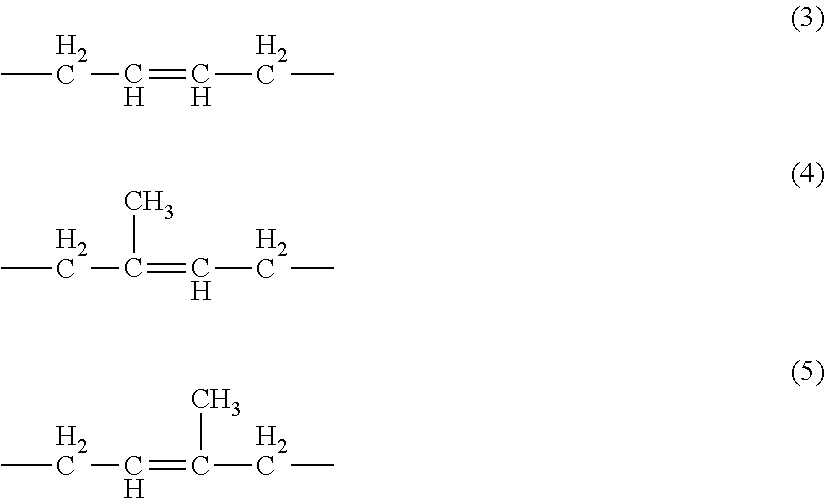Conjugated Diene Polymer, Conjugated Diene Polymer Composition, and Tire
a technology of conjugated diene and polymer composition, which is applied in the field of conjugated diene polymer composition, conjugated diene polymer composition, and tire, can solve the problems of poor dispersibility and low affinity of conjugated diene polymer, and achieve the effect of sufficient abrasion resistance and superior processability
- Summary
- Abstract
- Description
- Claims
- Application Information
AI Technical Summary
Benefits of technology
Problems solved by technology
Method used
Image
Examples
production example 1
[0353]Into a temperature-controllable autoclave of 40 L inner volume equipped with a stirrer and a jacket used as a reactor, 2,220 g of 1,3-butadiene, 780 g of styrene, 21,000 g of cyclohexane, and polar substances consisting of 2 g of tetrahydrofuran (THF) and 2.04 g of 2,2-bis(2-oxolanyl)propane (BOP) were loaded, where impurities had been removed from the materials in advance, and the inner temperature of the reactor was retained at 47° C.
[0354]As a polymerization initiator, 0.98 g of n-butyllithium (indicated as “nBL” in Tables) was fed to the reactor.
[0355]After the initiation of polymerization reaction, the temperature in the reactor began to elevate through heat generation due to polymerization, and ultimately reached 73° C.
[0356]Two minutes after the reaction temperature reached the peak, 0.65 g of silicon tetrachloride (indicated as “Cup1” in Tables) as a coupling agent was added to the reactor, and the resultant was subjected to coupling reaction for 10 minutes.
[0357]To th...
production example 2
[0361]Into a temperature-controllable autoclave of 40 L inner volume equipped with a stirrer and a jacket used as a reactor, 2,220 g of 1,3-butadiene, 780 g of styrene, 21,000 g of cyclohexane, and polar substances consisting of 2 g of tetrahydrofuran (THF), 3.20 g of 2,2-bis(2-oxolanyl)propane (BOP), and 2.37 g of piperidine (indicated as “Pip” in Tables) were loaded, where impurities had been removed from the materials in advance, and the inner temperature of the reactor was retained at 43° C.
[0362]As a polymerization initiator, 1.53 g of n-butyllithium was fed to the reactor.
[0363]After the initiation of polymerization reaction, the temperature in the reactor began to elevate through heat generation due to polymerization, and ultimately reached 74° C.
[0364]Two minutes after the reaction temperature reached the peak, 1.53 g of 2,2-dimethoxy-1-(3-trimethoxysilylpropyl)-1-aza-2-silacyclopentane (indicated as “Cup2” in Tables) as a coupling agent was added to the reactor, and the res...
production example 3
[0369]Into a temperature-controllable autoclave of 40 L inner volume equipped with a stirrer and a jacket used as a reactor, 2,040 g of 1,3-butadiene, 960 g of styrene, 21,000 g of cyclohexane, and polar substances consisting of 2 g of tetrahydrofuran (THF), 2.04 g of 2,2-bis(2-oxolanyl)propane (BOP), and 1.51 g of piperidine (Pip) were loaded, where impurities had been removed from the materials in advance, and the inner temperature of the reactor was retained at 45° C.
[0370]As a polymerization initiator, 0.98 g of n-butyllithium was fed to the reactor.
[0371]After the initiation of polymerization reaction, the temperature in the reactor began to elevate through heat generation due to polymerization, and ultimately reached 72° C.
[0372]Two minutes after the reaction temperature reached the peak, 0.85 g of 2,2-dimethoxy-1-(3-trimethoxysilylpropyl)-1-aza-2-silacyclopentane (Cup2) as a coupling agent was added to the reactor, and the resultant was subjected to coupling reaction for 10 m...
PUM
| Property | Measurement | Unit |
|---|---|---|
| molecular weight distribution | aaaaa | aaaaa |
| Tg | aaaaa | aaaaa |
| Tg | aaaaa | aaaaa |
Abstract
Description
Claims
Application Information
 Login to View More
Login to View More - R&D
- Intellectual Property
- Life Sciences
- Materials
- Tech Scout
- Unparalleled Data Quality
- Higher Quality Content
- 60% Fewer Hallucinations
Browse by: Latest US Patents, China's latest patents, Technical Efficacy Thesaurus, Application Domain, Technology Topic, Popular Technical Reports.
© 2025 PatSnap. All rights reserved.Legal|Privacy policy|Modern Slavery Act Transparency Statement|Sitemap|About US| Contact US: help@patsnap.com



